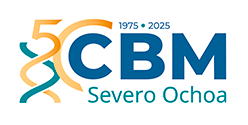Selected publications
Scientific program 1: Genome dynamics and function
Oligomerization regulates the interaction of Gemin5 with members of the SMN complex and the translation machinery
Rosario Francisco-Velilla, Salvador Abellan, Azman Embarc-Buh & Encarnacion Martinez-Salas
Published:
https://doi.org/10.1038/s41420-024-02057-5
RNA-binding proteins are multifunctional molecules impacting on multiple steps of gene regulation. Gemin5 was initially identified as a member of the survival of motor neurons (SMN) complex. The protein is organized in structural and functional domains, including a WD40 repeats domain at the N-terminal region, a tetratricopeptide repeat (TPR) dimerization module at the central region, and a non-canonical RNA-binding site at the C-terminal end. The TPR module allows the recruitment of the endogenous Gemin5 protein in living cells and the assembly of a dimer in vitro. However, the biological relevance of Gemin5 oligomerization is not known. Here we interrogated the Gemin5 interactome focusing on oligomerization-dependent or independent regions. We show that the interactors associated with oligomerization-proficient domains were primarily annotated to ribosome, splicing, translation regulation, SMN complex, and RNA stability. The presence of distinct Gemin5 protein regions in polysomes highlighted differences in translation regulation based on their oligomerization capacity. Furthermore, the association with native ribosomes and negative regulation of translation was strictly dependent on both the WD40 repeats domain and the TPR dimerization moiety, while binding with the majority of the interacting proteins, including SMN, Gemin2, and Gemin4, was determined by the dimerization module. The loss of oligomerization did not perturb the predominant cytoplasmic localization of Gemin5, reinforcing the cytoplasmic functions of this essential protein. Our work highlights a distinctive role of the Gemin5 domains for its functions in the interaction with members of the SMN complex, ribosome association, and RBP interactome.
Nucleolar stress caused by arginine-rich peptides triggers a ribosomopathy and accelerates aging in mice
Oleksandra Sirozh, Anabel Saez-Mas, Bomi Jung, Laura Sanchez-Burgos, Eduardo Zarzuela, Sara Rodrigo-Perez, Ivan Ventoso, Vanesa Lafarga, Oscar Fernandez-Capetillo
Published: 18 April 2024
https://doi.org/10.1016/j.molcel.2024.02.031
Oleksandra Sirozh, Anabel Saez-Mas, Bomi Jung, Laura Sanchez-Burgos, Eduardo Zarzuela, Sara Rodrigo-Perez, Ivan Ventoso, Vanesa Lafarga, Oscar Fernandez-CapetilloNucleolar stress (NS) has been associated with age-related diseases such as cancer or neurodegeneration. To investigate how NS triggers toxicity, we used (PR)n arginine-rich peptides present in some neurodegenerative diseases as inducers of this perturbation. We here reveal that whereas (PR)n expression leads to a decrease in translation, this occurs concomitant with an accumulation of free ribosomal (r) proteins. Conversely, (PR)n-resistant cells have lower rates of r-protein synthesis, and targeting ribosome biogenesis by mTOR inhibition or MYC depletion alleviates (PR)n toxicity in vitro. In mice, systemic expression of (PR)97 drives widespread NS and accelerated aging, which is alleviated by rapamycin. Notably, the generalized accumulation of orphan r-proteins is a common outcome of chemical or genetic perturbations that induce NS. Together, our study presents a general model to explain how NS induces cellular toxicity and provides in vivo evidence supporting a role for NS as a driver of aging in mammals.
A Proteogenomic Approach to Unravel New Proteins Encoded in the Leishmania donovani (HU3) Genome
Javier Adán-Jiménez, Alejandro Sánchez-Salvador, Esperanza Morato, Jose Carlos Solana, Begoña Aguado, and Jose M. Requena
Published: 13 June 2024
https://doi.org/10.3390/genes15060775
The high-throughput proteomics data generated by increasingly more sensible mass spectrometers greatly contribute to our better understanding of molecular and cellular mechanisms operating in live beings. Nevertheless, proteomics analyses are based on accurate genomic and protein annotations, and some information may be lost if these resources are incomplete. Here, we show that most proteomics data may be recovered by interconnecting genomics and proteomics approaches (i.e., following a proteogenomic strategy), resulting, in turn, in an improvement of gene/protein models. In this study, we generated proteomics data from Leishmania donovani (HU3 strain) promastigotes that allowed us to detect 1908 proteins in this developmental stage on the basis of the currently annotated proteins available in public databases. However, when the proteomics data were searched against all possible open reading frames existing in the L. donovani genome, twenty new protein-coding genes could be annotated. Additionally, 43 previously annotated proteins were extended at their N-terminal ends to accommodate peptides detected in the proteomics data. Also, different post-translational modifications (phosphorylation, acetylation, methylation, among others) were found to occur in a large number of Leishmania proteins. Finally, a detailed comparative analysis of the L. donovani and Leishmania major experimental proteomes served to illustrate how inaccurate conclusions can be raised if proteomes are compared solely on the basis of the listed proteins identified in each proteome. Finally, we have created data entries (based on freely available repositories) to provide and maintain updated gene/protein models. Raw data are available via ProteomeXchange with the identifier PXD051920.
Sexual dimorphism in the antitumor immune responses elicited by the combination of fasting and chemotherapy
Andrés Pastor-Fernández, Manuel Montero Gómez de las Heras, Jose Ignacio Escrig-Larena, Marta Barradas, Cristina Pantoja, Adrian Plaza, Jose Luis Lopez-Aceituno, Esther Durán, Alejo Efeyan, Maria Mittelbrunn, Lola Martinez, Pablo Jose Fernandez-Marcos
Published: 21 March 2024
https://doi.org/10.1002/cac2.12535
Fasting reduces chemotherapy toxicity, enhancesimmunogenic tumor cell death and increases CD8+T cell infiltration in tumors, particularly when combinedwith chemotherapy or immunotherapy. More-over, fasting exhibits a sexual dimorphism in the immunesystem. The aim of our study was to elucidate the role ofsex in the beneficial anti-tumoral effects of combiningfasting and chemotherapy.
